We all like to look smart. But when it comes down to workwear there’s more to it than fashion, it’s a vital part of a company’s image. Here, Bob Bluffield looks at the industry and its latest developments.
TO HAVE - OR TO HAVE NOT?
The UK workwear market is substantial; the latest available figures released for 2009* revealed that British businesses spent €640.9 million and accounted for 19.1 per cent of the total Western European spend on workwear. Furthermore the industry is predicted to continue to grow at the rate of 3.3 per cent a year until 2016.

With what is at stake it is no surprise that the industry is fiercely competitive and takes itself very seriously. Workwear, as well as being practical, now plays an essential role as a marketing aid in tens of thousands of companies in most industries. Companies benefit from their staff wearing logoed clothing to enhance awareness of their business, while their staff generally agrees that having comfortable workwear linking them to their employer helps to establish unity and a feel good factor. The advantages of providing staff with branded clothing simply cannot be ignored, particularly when you have frontline personnel that are in regular face-to-face contact with customers. And, if your business does not already consider the merits of providing workwear, perhaps you should be asking yourself why?
The growth in the workwear market during this tough trading climate suggests that companies attach great importance to the appearance of their staff. The removals industry, specifically as it employs teams that work within a customer's environment, have a need for their staff to dress professionally. While some may complain about paying for staff clothing, the majority of established businesses appear to concur that buying corporate workwear is an expense that is both necessary and worthwhile.
The corporate identity challenge
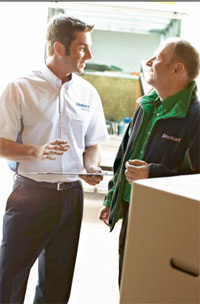 Removal companies have responded well to the corporate identity challenge and most regard appropriately branded clothing with a similar level of importance as maintaining a pro-active Internet presence. Good quality workwear gets noticed and will help a business to develop a positive identity. When uniformed staff arrive at a client's home they become immediately identifiable by looking presentable and by fostering a professional image will gain respect and will instil customer confidence. The days when a removal crew would turn up in a battered old truck wearing an assortment of clothing that looked tired, scruffy and at times torn and inappropriate should have long gone. Doubtless, there will be a few dissenters that still refuse to acknowledge that setting high standards is paramount, but they will usually struggle at the low-cost end of the market and their survival is far from assured.
Removal companies have responded well to the corporate identity challenge and most regard appropriately branded clothing with a similar level of importance as maintaining a pro-active Internet presence. Good quality workwear gets noticed and will help a business to develop a positive identity. When uniformed staff arrive at a client's home they become immediately identifiable by looking presentable and by fostering a professional image will gain respect and will instil customer confidence. The days when a removal crew would turn up in a battered old truck wearing an assortment of clothing that looked tired, scruffy and at times torn and inappropriate should have long gone. Doubtless, there will be a few dissenters that still refuse to acknowledge that setting high standards is paramount, but they will usually struggle at the low-cost end of the market and their survival is far from assured.
During researching this article, I found no evidence to suggest that any mainstream moving companies are ignoring the advantages to be gained by having smartly turned out crews. By and large I have been impressed by the number of movers that acknowledge the benefits corporate workwear can offer. As might be expected, the least image conscious tends to be in the individually owned man-and-van sector of the industry. Yet, even here there is sufficient evidence that owner driver operations are increasingly taking on board the importance of creating a good impression and this includes ensuring that they dress appropriately. Nevertheless, if this area of the industry wants to be taken seriously it is vital for all legitimate one-man, one-van business owners to consider smartening up their acts if they are to escape from the 'fly-by-night' reputations that the public, often justifiably, still considers many of them to be.
Not just for big companies
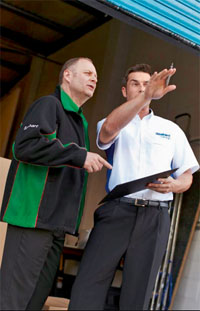 Some of the more established man-and-van operations already understand that creating a memorable corporate image will help their businesses to grow in stature. Trawl the web and you'll find numerous companies across the country that are proud to proclaim that their van drivers wear uniforms, among them Man and Van Removals of Taunton and Man and Van Sussex.
Some of the more established man-and-van operations already understand that creating a memorable corporate image will help their businesses to grow in stature. Trawl the web and you'll find numerous companies across the country that are proud to proclaim that their van drivers wear uniforms, among them Man and Van Removals of Taunton and Man and Van Sussex.
Sadly this message has not got through to everyone. It came as a shock when an organisation that claims to be a 'leading removals company ... offering a range of removal, relocation and logistic solutions,' Man Van London, were surprisingly hostile when I approached them to discuss their workwear policy. I was bluntly told that their removal staff "... do not have corporate workwear". When I pressed for more comment by asking why they did not consider uniforms to be important, I was promptly given the cold shoulder.
This is in steep contrast to Aussie Man & Van, a business founded in 2003 that ironically went into Administration around Christmas, that had established a high profile in London with their fleet of liveried vans and a workforce that wore black and yellow uniforms emblazoned with the company logo. The widespread acceptance of workwear by so many full service removal companies as well as small van operators tends to scupper a comment made to me by one corporate leading clothing supplier who said: "The removal industry has, by and large, been its own worst enemy. In some quarters the man-and-van mindset is still in evidence at some companies, and for the industry to develop it needs to move with the times by projecting a more professional image that can be achieved, in part at least, by considering the marketing value of good workwear against the cost.”
From what I have seen, this statement does not really hold up to scrutiny. Considerable time spent studying removal company websites suggests the reality to be far more positive. I found that almost all of the established movers across the UK with websites (and many with downloadable brochures) include photographs of packers and movers dressed in branded workwear. While this does not necessarily confirm that all companies kit out all of their removal crews with appropriate workwear, equally it would be difficult to imagine that they had bought specific logoed items merely to embellish the appearance of the staff featured in their publicity. It therefore follows that the majority, if not all, major removals companies embrace an understanding of the long-term benefits associated with providing staff with good workwear. It seems they are very wise to the fact that workwear can be used to enhance their corporate profiles and as a way to foster a team spirit and sense of identity within their workforces.
The first impression
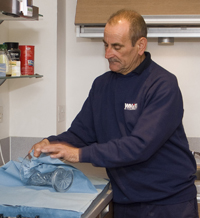 In today's competitive environment customers rightly demand that the staff of companies they hire to be entrusted with moving their property must not only act professionally but also need to be dressed appropriately. Vital impressions are often formed by the way people dress. There is no doubt that smartly attired crews can be crucial to a company's reputation; and, just as many tend to judge a book by its cover, customers tend to judge a company by its workers. Smartly attired removal crews wearing matching garments bearing their employer's logo will create a long-lasting impression that can speak volumes about the ethos and attitude of a company. Conversely, a firm that employs the best moving crews in the world will be viewed as uncaring amateurs if its staff arrive at a client's premises wearing grubby old jeans and a mixture of tacky sweatshirts printed with slogans.
In today's competitive environment customers rightly demand that the staff of companies they hire to be entrusted with moving their property must not only act professionally but also need to be dressed appropriately. Vital impressions are often formed by the way people dress. There is no doubt that smartly attired crews can be crucial to a company's reputation; and, just as many tend to judge a book by its cover, customers tend to judge a company by its workers. Smartly attired removal crews wearing matching garments bearing their employer's logo will create a long-lasting impression that can speak volumes about the ethos and attitude of a company. Conversely, a firm that employs the best moving crews in the world will be viewed as uncaring amateurs if its staff arrive at a client's premises wearing grubby old jeans and a mixture of tacky sweatshirts printed with slogans.
In many companies wearing approved workwear provided by the employer has become compulsory. One such is Simpsons Removals and Storage, a family firm with a workforce of around 50 that operates 16 vehicles from its Kent depot and another four from Chesterfield. Steve Simpson told me that they "... attach great importance to the appearance of our crews. We provide the full kit; black trousers, dark grey t-shirts, polo shirts, button-up shirts as well as summer and winter jackets. We no longer buy fleeces because we feel they tend to look shabby too quickly. The workwear we provide goes down extremely well with our staff who appreciate not having to wear their own clothing”.
| Looking cool with Kes 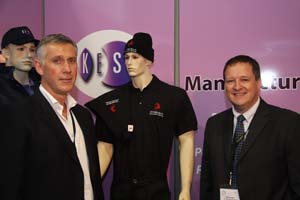
Kes is a relative newcomer to the uniforms market. It all started a year or so ago when Peter Gosling, now a Key Account Manager, joined the company bringing with him expertise in this market. Since then the company has landed some high profile accounts and was an exhibitor at The Movers & Storers Show in November last year. Until then Kes was known as a packaging supplier. Although the packaging business is still the mainstay of the company (see The Mover, February 2012), Kes is constantly looking to expand its product range to meet the needs of its customers. Peter said that all the big moving and international companies use uniforms for their staff. But it’s important for small companies to create a good impression too. “We are quite happy to handle small orders as well as the big ones,” said Peter. “Orders for a dozen items are quite common and economical.” Of course the cost depends on quantity and the level of branding. Large logos are probably best done by heat transfer printing whereas smaller work is usually done by embroidery. Setting up the machine can be the largest single cost for small orders however, for longer runs, the set up costs are insignificant. The fashion today seems to be for polo shirts, sweatshirts and fleeces, perhaps with a body warmer in the winter. “Body warmers keep out the cold but allow porters the flexibility they need when handling furniture,” said Peter. “I would recommend a 65/35 polyester/cotton mix for polo shirts as the best material blend. It’s hard wearing, allows the fabric to breathe and keeps its shape well when washed.” Trousers nowadays are usually the cargo pant type with lots of pockets for essential items or just to look cool. Headgear, if worn, is usually in the form of a baseball cap or a woolly hat if the weather is really cold. www.paperblankets.com |
Functional as well as smart
Choosing the right workwear is crucial. As Dawn Ashworth, Brand Manager for Simon Jersey pointed out: "It is extremely important to ensure that any workwear is functional for the job being done and is appropriate for the time of year.” Simon Jersey is a leading uniform specialist and part of Kwintet, Europe's biggest corporate suppliers with a turnover of $700 million. The company is responsible for designing and supplying the 5,000 multitask workforce at 40 Stobart Group sites so they know what they are talking about. Dawn explained: "Of particular concern to the moving industry is that a garment is fit for purpose and will not hinder employees while they are getting on with their jobs.“
“Our catalogue includes uniform pieces suitable for a range of employees from drivers to office staff, and everything in between. Our range includes combat trousers, polo shirts, soft shell fleeces and high visibility jackets, as well as shirting and suiting. We also supply a boot with a cut away heel, offering greater ease of movement and protection from injury.”
Dawn's comments are echoed by Scott Arlett of APT Workwear of Henley-on-Thames who emphasises the need to buy workwear of good quality. "We are very focussed and share peace of mind with our customers in being confident that we have supplied garments that have been 'proved, worn, washed, tried and tested' over many years. We know from experience that price is not everything and arguably quality should be put before price whenever possible. We always highlight the downside of cheaper brands and there are several such brands that we would not supply because history has taught us that they are not sufficiently robust. In the end you only can expect to get what you pay for.”
| Embroidery 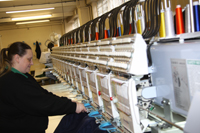 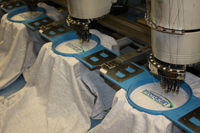
The workshops at Haywoods in Leeds include this 15-head embroidery machine that can embroider logos and designs of 15 garments simultaneously. Martin Haywood said that because the machine operates in this way, it’s most economic to order garments in multiples of 15. Photo: 15-head embroidery machine. |
What to wear
Clothing preferences vary between moving companies and while not all supply staff with a full range of clothing, most provide polo shirts, sweatshirts or t-shirts. Martin Haywood, who runs the Leeds-based family workwear and packaging supplier Haywoods, confirmed that, "While some firms are happy to go the whole hog by providing boots, trousers or shorts, the majority will still only buy clothing for the upper body and although a few still buy ties these are now considered 'old hat'. Smart casual is the trend now. Hoodies are also growing in popularity.”
Steve Mobley of Wincanton based movers Armishaws told me that his company invests considerably at least five times a year in an extensive range of workwear items that includes trousers, shorts, t-shirts, sweatshirts, fleeces, hi-viz vests and jackets and safety shoes. He quoted "the cost" as being the major downside of buying workwear but added "People like to see staff in uniform; it reinforces company identity and gives clients increased confidence”.
Worth the money
However, while the cost of buying high quality workwear has to be considered, when the 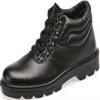 image enhancing and other benefits it brings to a removal company are taken into account, most consider it a worthwhile expense. "Although we offer very good prices companies should know that they don't always have to buy in bulk," Martin Haywood told me. "We can offer fixed prices but we are also happy to supply workwear in very small quantities. It is actually surprisingly inexpensive to kit out a workforce. Based on 12-wearers, we can provide a polo shirt, sweatshirt and polyester trousers, including embroidery, from as little as £55 per person.” Scott Arlett of APT Workwear added: "We can kit out a new staff member with what we call a 'Man Pack' comprised of five quality polo shirts; two hard-wearing sweatshirts; two pairs of well manufactured cargo trousers; and a fleece all for an average cost of £130 excluding VAT, including embroidery of a logo on the chest of a garment.”
image enhancing and other benefits it brings to a removal company are taken into account, most consider it a worthwhile expense. "Although we offer very good prices companies should know that they don't always have to buy in bulk," Martin Haywood told me. "We can offer fixed prices but we are also happy to supply workwear in very small quantities. It is actually surprisingly inexpensive to kit out a workforce. Based on 12-wearers, we can provide a polo shirt, sweatshirt and polyester trousers, including embroidery, from as little as £55 per person.” Scott Arlett of APT Workwear added: "We can kit out a new staff member with what we call a 'Man Pack' comprised of five quality polo shirts; two hard-wearing sweatshirts; two pairs of well manufactured cargo trousers; and a fleece all for an average cost of £130 excluding VAT, including embroidery of a logo on the chest of a garment.”
Good materials are essential
Suppliers agree on one point; that it is essential that all workwear is made from good materials although cost will inevitably be a determining factor. Scott Arlett continued: "The material composition is critical if the comfort of the wearer is to be assured. In hot conditions we would suggest a CoolPlus polo, which will help to keep the body cooler and perspiration away from the upper body. Technical garments do however cost more than the poly/cotton items that are widely used by movers. Prices have been a problem caused by the highly volatile market that significantly forced up the cost of natural fibres such as cotton and man-made materials such as polyester at the beginning of 2011. But costs have started to come down again and we are confident that prices will stabilise to the 2010 level over the course of this calendar year.”
Keeping it simple
Martin Haywood also offers some sound advice that should be taken into account concerning branding. "Designers can show a tendency to create very complicated logos with lots of colours and too much fine detail. It's a misconception to think that complex design detail that can be reproduced well on paper will readily translate to clothing because frequently it won't. It is far better to keep designs fairly simple for best results and to use embroidery instead of printing as this tends to last longer and is not limited by colours.”
Many workwear suppliers are long established and will have witnessed changes brought about by better designs, stronger colours and improved materials that have all contributed to far more sophistication within the industry. In the removal industry overalls and heavy donkey jackets may once have been the norm for many firms, but today clothing has to be practical, comfortable, clean, and stylish with t-shirts and polos being the most popular items for movers and smarter shirts and blouses worn by staff that need to be more formal.
Differentiating job functions
Scott Arlett of APT Workwear used the Business Moves Group (BMG) as a case study to illustrate the range of workwear that his company supplies. "BMG is a diverse business. It now covers removals, IT solutions, recycling and storage all supporting the relocation process. They, like others, differentiate their staff by different shirt colours that are determined by the area they work within. All staff wear the same proven hard-wearing black cargo trouser. Team leaders also have black as their colour theme with 'Team Leader' added below the embroidered BMG logo, while the team members wear purple shirts.” One of the problems when buying workwear, according to Steve Simpson is "With guys of all shapes and sizes it can be difficult buying the right number of garments that will fit everyone”. Scott Arlett answers this point by arguing that he can "... supply polo shirts in selected colours that come in sizes from XS to 5XL"
| Being Bold 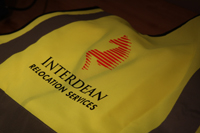 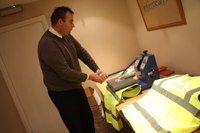 It makes sense to be bold with your logos when on soft fabrics such a fleeces. If the logo is very delicately designed the stitching can appear to get lost within the fabric itself. This Interdean logo stands out nicely. |
The tax implications
It is also important to consider the tax implications that relate to workwear. If plain clothing is issued free of charge to staff that can be worn outside of work, this will be considered as a 'fringe benefit' by HMRC and is therefore taxable. If a garment cannot be clearly defined as having been purchased for use as workwear, the employer or employee can be liable to pay tax at 20 per cent of the cost price. To overcome this, clothing that is specifically bought to use for work carries what are known as 'tax tabs'. These are usually small visible permanent labels that carry the logo or branding of the employer to clearly distinguish an item as workwear that has not been purchased with the intent of being worn for leisure.
To maintain a keen competitive edge, particularly when the trading environment is harsh, businesses need to carefully consider the value of any marketing tools that can help create a high profile. Considering the overall impression smartly and functionally dressed staff can create, any mover that is still unconvinced that investing in good quality workwear is money well spent may be missing an obvious opportunity to increase their company's exposure. With the wide range of products available there probably has never been a better time to buy workwear.
* Frost & Sullivan's Western Workwear Report published 2010